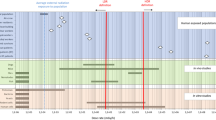Abstract
An antiulcer drug, 4-(2-carboxyethyl) phenyl trans 4-aminomethylcyclohexane carboxylate hydrochloride (DV-1006), was studied for mutagenicity using bacterial systems, in vitro and in vivo cytogenetics, and dominant lethal tests.
No mutagenicity of DV-1006 was observed either in the rec-assay on Bacillus subtilis or in the Salmonella/microsome test (Ames test). In in vitro cytogenetics, DV-1006 had no effects on the chromosomes of Chinese hamster cells at cytotoxic doses. Rats were treated singly or on 5 consecutive days orally with dose levels of 16, 160, or 1600 mg DV-1006/kg for detecting cytogenetic effects in vivo. As a result, no increase of the incidence of chromosomal aberrations in bone marrow cells was observed in any group of DV-1006. A single or 5 daily oral administration of DV-1006 (16 or 1600 mg/kg) to male mice and subsequent mating for 8 weeks produced no dominant lethal mutational effects. These results show that DV-1006 has no mutagenic potential.
Similar content being viewed by others
References
Ames, B. N., Durston, W. E., Yamasaki, E., Lee, F. D.: Carcinogens are mutagens: a simple test system combining liver homoginates for activation and bacteria for detection. Proc. Natl. Acad. Sci. USA 70, 2281–2285 (1973)
Ames, B. N., McCann, J., Yamasaki, E.: Methods for detecting carcinogens and mutagens with the Salmonella/mammalian-microsome mutagenicity test. Mutat. Res. 31, 347–364 (1975)
Bender, M. A., Griggs, H. G., Bedford, J. S.: Mechanisms of chromosomal aberration production III. Chemicals and ionizing radiation. Mutat. Res. 23, 197–212 (1974)
Brusick, D. J.: In vitro mutagenesis assays as predictors of chemical carcinogenesis in mammals. In: Toxicology Annual (C. L. Winek, ed.), Vol. 2, pp. 79–110. New York: Marcel Dekker 1977
Cohen, M. M., Hirschhorn, K.: Cytogenetic studies in animals. In: Chemical mutagens: principles and methods for their detection (A. Hollaender, ed.), Vol. 2, pp. 515–534. New York: Plenum Press 1971
Ehling, U. H., Cumming, R. B., Mailing, H. V.: Induction of dominant-lethal mutations by alkylating agents in male mice. Mutat. Res. 5, 417–428 (1968)
Ehling, U. H., Machemer, L., Buselmaier, W., Dycka, J., Frohberg, H., Kratochvilova, J., Lang, R., Lorke, D., Müller, D., Peh, J., Röhrborn, G., Roll, R., Schultz-Schencking, M., Wiemann, H.: Standard protocol for the dominant lethal test on male mice. Set up by work group “Dominant lethal mutations on the ad hoc committee chemogenetics”. Arch. Toxicol 39, 173–185 (1978)
Epstein, S. S.: Recommended procedures for testing genetic hazards from chemicals, based on the induction of dominant lethal mutations in mammals. Nature 230, 459–460 (1971)
Epstein, S. S., Arnold, E., Andrea, J., Bass, W., Bishop, Y.: Detection of chemical mutagens by the dominant lethal assay in the mouse. Toxicol. Appl. Pharmacol. 23, 288–325 (1972)
Green, S., Zeiger, E., Palmer, K. A., Springer, J. A., Legator, M. S.: Protocols for the dominant lethal test, host-mediated assay and in vivo cytogenetic test used in the Food and Drug Administration's review of substances in the GRAS (generally recognized as safe) list. J. Toxicol. Environ. Health 1, 921–928 (1976)
Hashizume, T., Asano, M., Aibara, S., Irie, K., Hirokawa, K., Fujita, H., Kasahara, A.: Antiulcer effect and pharmacological properties of 4-(2-carboxyethyl) phenyl trans-4-aminomethylcyclohexane carboxylate hydrochloride (DV-1006). Pharmacometrics 12, 691–702 (1976)
Kada, T., Sadaie, Y., Tutikawa, K.: In vitro and host-mediated “rec-assay” procedures for screening chemical mutagens: and phloxine, a mutagenic red dye detected. Mutat. Res. 16, 165–174 (1972)
Kada, T., Moriya, M., Shirasu, Y.: Screening of pesticides for DNA interactions by “rec-assay” and mutagenesis testing, and frameshift mutagens detected. Mutat. Res. 26, 243–248 (1974)
McCann, J., Choi, E., Yamasaki, E., Ames, B. N.: Detection of carcinogens as mutagens in the Salmonella/microsome test: Assay of 300 chemicals. Proc. Natl. Acad. Sci. USA 72, 5135–5139 (1975)
McCann, J., Ames, B. N.: Detection of carcinogens as mutagens in the Salmonella/microsome test: Assay of 300 chemiclas: Discussion. Proc. Natl. Acad. Sci. USA 73, 950–954 (1976)
Nichols, W. W., Moorhead, P., Brewen, G.: Chromosome methodologies in mutation testing, Ad Hoc Committee report. Toxicol. Appl. Pharmacol. 22, 269–275 (1972)
Oakberg, E. F.: Duration of spermatogenesis in the mouse and timing of stage of the cycle of the seminiferous epithelium. Am. J. Anat. 99, 507–516 (1956)
Ono, K., Okazaki, O., Saito, T., Sano, M., Akimoto, T.: Metabolism of 4-(2-carboxyethyl) phenyl trans-4-aminomethylcyclohexane carboxylate hydrochloride (DV-1006), a new antiulcer drug, (1) abortion, distribution, excretion and metabolism in rats. Pharmacometrics 12, 269–277 (1976)
Onodera, T., Ohno, H., Akiyama, Y., Hoshina, T., Akimoto, T.: Acute toxicity of 4-(2-carboxyethyl) phenyl trans-4-aminomethylcyclohexane carboxylate hydrochloride (DV-1006), a new antiulcer drug, and its several metabolites. Pharmacometrics 12, 265–267 (1976)
Purchase, I. F. H., Longstaff, E., Ashby, J., Styles, J. A., Anderson, D., Lefevre, P. A., Westwood, F. R.: Evaluation of six short term tests for detecting organic chemical carcinogens and recommendation for their use. Nature 264, 624–627 (1976)
Ray, U. A., Holden, H. E., Salsburg, D. S., Ellis, J. H., Just, L. J., Jr., Hyneck, M. L.: Comparative studies of the ethylmethanesulfonate-induced mutations with host-mediated, dominant lethal and cytogenetic assays. Toxicol. Appl. Pharmacol. 30, 107–116 (1974)
Röhrborn, G.: The dominant let hals: Method and cytogenetic examination of early cleavage stages. In: Chemical mutagenesis in mammals and man (F. Vogel, G. Röhrborn, eds.), pp. 148–155. Berlin, Heidelberg, New York: Springer 1970
Shimada, H., Nagai, E., Monta, H., Akimoto, T.: Mutagenicity studies of tranexamic acid. Pharmacometrics (in press, 1979)
Shubik, P.: General criteria for assessing the evidence for carcinogenicity of chemical substances: Report of the subcommittee on environmental carcinogens, National Cancer Advisory Board. J. Natl. Cancer Inst. 58, 461–465 (1977)
Sugimura, T., Sato, S., Nagao, M., Yahagi, T., Matsushima, T., Seino, Y., Takeuchi, M., Kawachi, T.: Overlapping of carcinogens and mutagens. In: Fundamentals in cancer prevention (P. N. Magee et al., eds.), pp. 191–215. Tokyo: University of Tokyo Press 1976
Suzuki, Y., Sudo, H., Yamagami, I.: Lecture no. 7N 4–5 in the 96th meeting of Japan Pharmaceutical Society, 1976
Author information
Authors and Affiliations
Rights and permissions
About this article
Cite this article
Shimada, H., Suzuki, K., Morita, H. et al. Mutagenicity studies. Arch Toxicol 42, 249–258 (1979). https://doi.org/10.1007/BF00334838
Received:
Issue Date:
DOI: https://doi.org/10.1007/BF00334838




